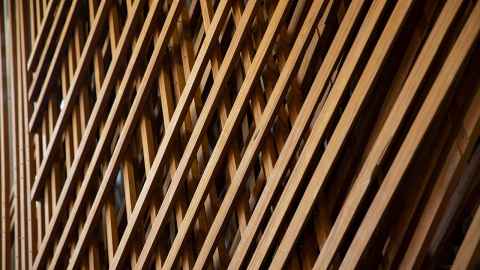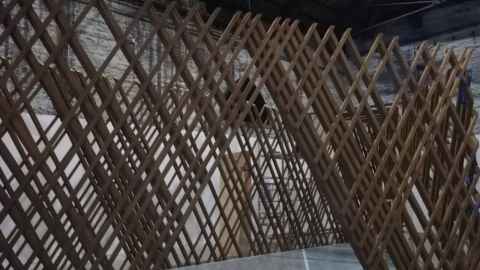University team weaves with wood in the Biennale Architettura in Venice
27 May 2021
After a year of uncertainty, the 17th International Architecture Exhibition of the La Biennale di Venezia in 2021 has opened, and features the installation "Learning from Trees: transforming timber culture in Aotearoa" from the School of Architecture and Planning.

La Biennale di Venezia, or Architecture Biennale, is the leading and longest-running architectural event in the world, and runs in alternate years to the Art Biennale, with more than 60 countries participating.
It is an invitation for architects and designers to explore questions and possible solutions to respond to current social and environmental pressures. Each pavilion is curated in response to an overall theme, which in 2021 is “how will we live together?”.
Unusually, the School was invited to exhibit in the Italian Pavilion, which is curated by Professor Alessandro Melis, a former staff member at the School of Architecture and Planning.
The theme for the Italian Pavilion is ‘resilient communities’, which is reflected in the team’s installation, Learning from Trees: transforming timber culture in Aotearoa. It was designed to showcase the opportunities offered by the use of timber as a building material, especially in terms of carbon sequestration and earthquake resistance.
Learning from Trees is a complex lattice-like 35m2 structure that looks as if it has been woven, only out of wood. It is comprised of 436 ‘sticks’, 287 brackets and, if the sticks were lined up end-to-end, 1.2 kilometres of timber. Crossing through the enclosure is a long seating bench made from digitally-tooled kauri, rescued from a former Housing New Zealand house and which highlights the potential of salvaged and refurbished timber.
Learning from Trees draws on New Zealand’s history of building with timber, both our colonial and well as Pacific architectural provenance, which is sometimes described as ‘stick architecture’.

“But new technologies, such as BIM [Building Information Modelling] is allowing us to model and construct with wood in a way that would not be possible by hand,” says Dr Michael Davis, School of Architecture and Planning and a member of the project team. “So this is a way to draw attention to new ways of working with wood that has been made possible by new technologies and fabrication techniques, that builds on and advances our manual and craft traditions.”
Timber is having an international renaissance, particularly as a sustainable building material, says team leader Associate Professor Kathy Waghorn, formerly of the School of Architecture and Planning and now at the Auckland University of Technology. “There’s an increasing recognition of the need for a sustainable material that can add to rather than take from carbon storage, which is what trees do.”
“As we recognise the importance and urgency for New Zealand to achieve the 2030 United Nations’ Sustainable Development Goals and the targets of the Paris Agreement, the building industry needs to reflect on the role and impacts of constructions holistically” says Associate Professor Paola Boarin, School of Architecture and Planning and member of the project team. “Timber provides the opportunity to achieve both high quality architecture and reduced carbon footprints in our cities, and the abundance of this material, as well as the dominant timber construction culture, places New Zealand in a unique position.”
The team spent much of the summer of 2020 testing the methodology of the construction of the exhibition – how to fit all the pieces together. They also timed themselves. “We estimated that it would take about ten days to construct the timber pavilion in Venice,” says Dr Waghorn.
The installation of many, many parts was shipped off to Venice in February 2020, with each of the 426 ‘sticks’ given a unique label, and each package of sticks weighed to ensure that it can be carried by two people. Unfortunately, the covid-19 pandemic had put the Biennale Architettura on hold and the installation has been sitting in the Venice Arsenale since it reached the Italian shores in April 2020.
In recent weeks the New Zealand and Italian teams worked together with the Biennale technical team to oversee the construction of the installation remotely, ready for the opening on 22 May.
Exhibiting in the Italian pavilion means the installation will be seen by thousands of people from around the world, it being one the most popular and most central pavilions, at an event in which space is sought after and hard to come by.
“It’s very unusual for a university from outside Italy to be invited to exhibit in the Italian pavilion,” says Dr Waghorn, “but Alessandro Melis taught at the School, and was extremely interested in the country’s traditions in working with timber, and our research on the material”.
New Zealand is well-positioned, both in our ability to sustainably grow timber as a building material and with our timber-orientated construction culture which has fostered innovations in fabrication techniques and the use of new technologies.
This is a rare New Zealand presence at the La Biennale di Venezia. In 2014 and 2016, New Zealand’s participation was supported and organised by the New Zealand Institute (NZIA); Dr Waghorn was co-director of New Zealand’s “Future Islands” exhibition in 2016.
The School was also invited to participate in a student competition in the 5th Architecture Biennale in 1991 and was awarded the Venice Prize (a ‘best-in-show”, an equivalent to the current Golden Lion). The students who worked on that project included Andrew Barrie, now a Professor at the School and a member of the Learning From Trees team.
The School’s – that is, New Zealand’s — participation in 2021 has been supported by the Italian Government, the University of Auckland’s Faculty Research and Development Fund, the School of Architecture and Planning’s Performance-Based Research Fund, and through product sponsorship from Abodo, an Auckland-based architectural timber supplier, and Spax, a specialist for connection technology.
The 17th edition of the La Biennale di Venezia runs from 22 May to 21 November 2021.
Read more at the official website of the Italian Pavilion 2021 and La Biennale.
Media contact
Margo White I Media adviser
DDI 09 923 5504
Mob 021 926 408
Email margo.white@auckland.ac.nz